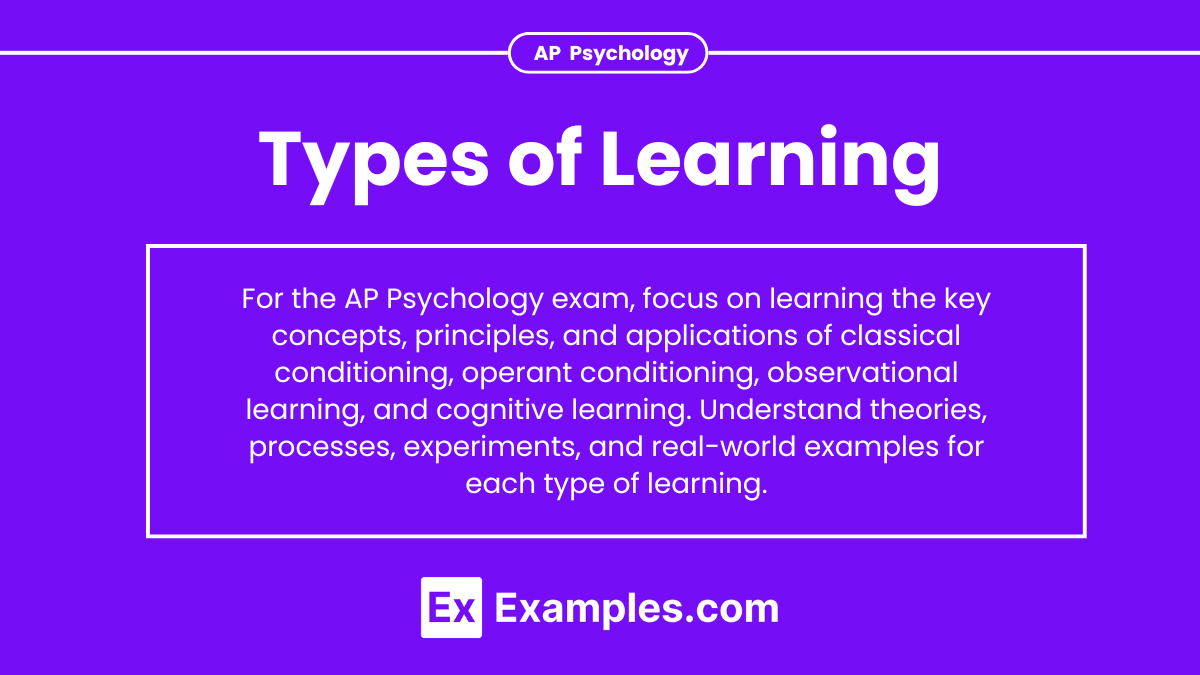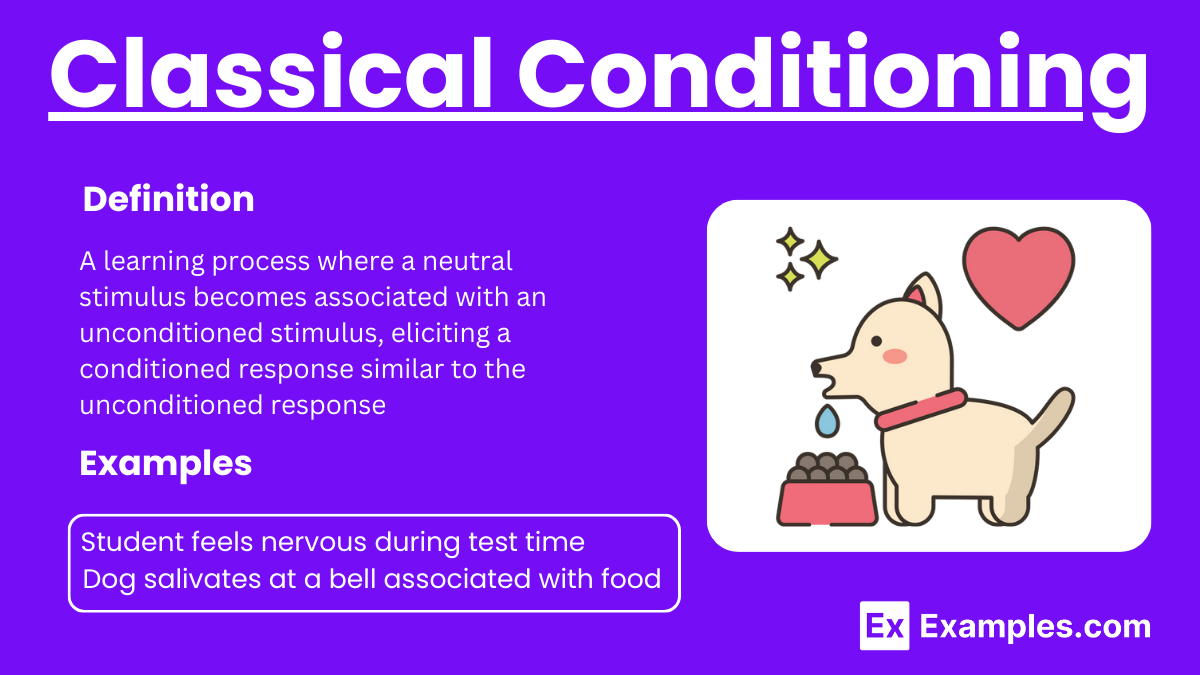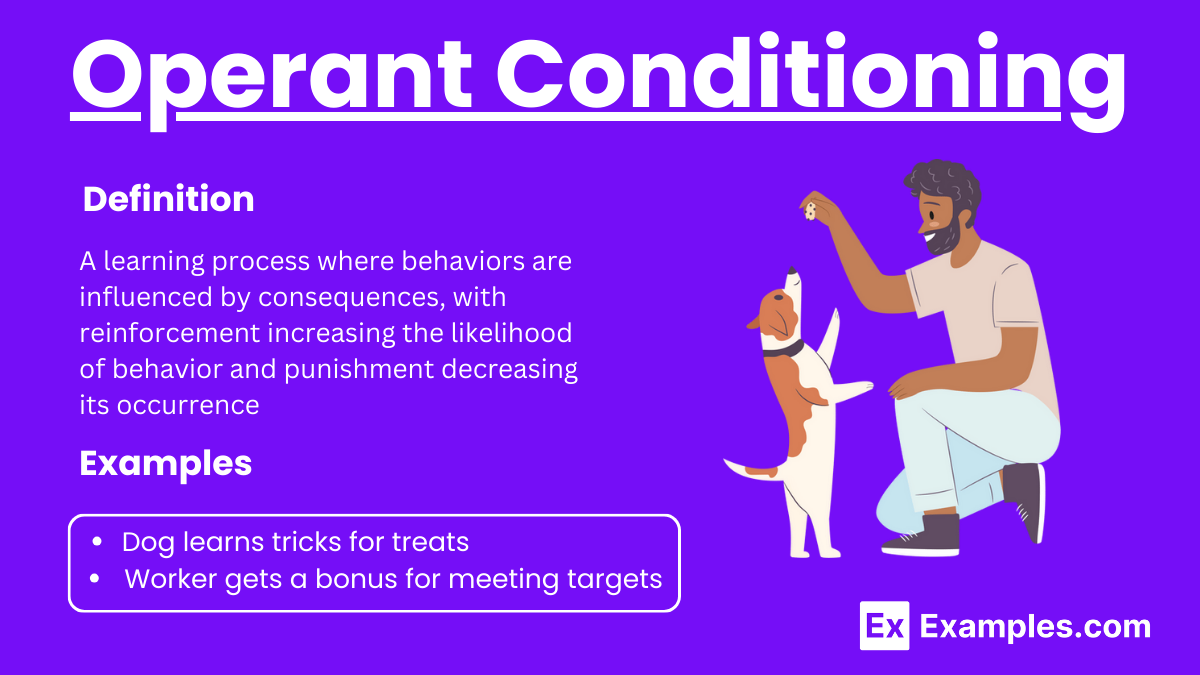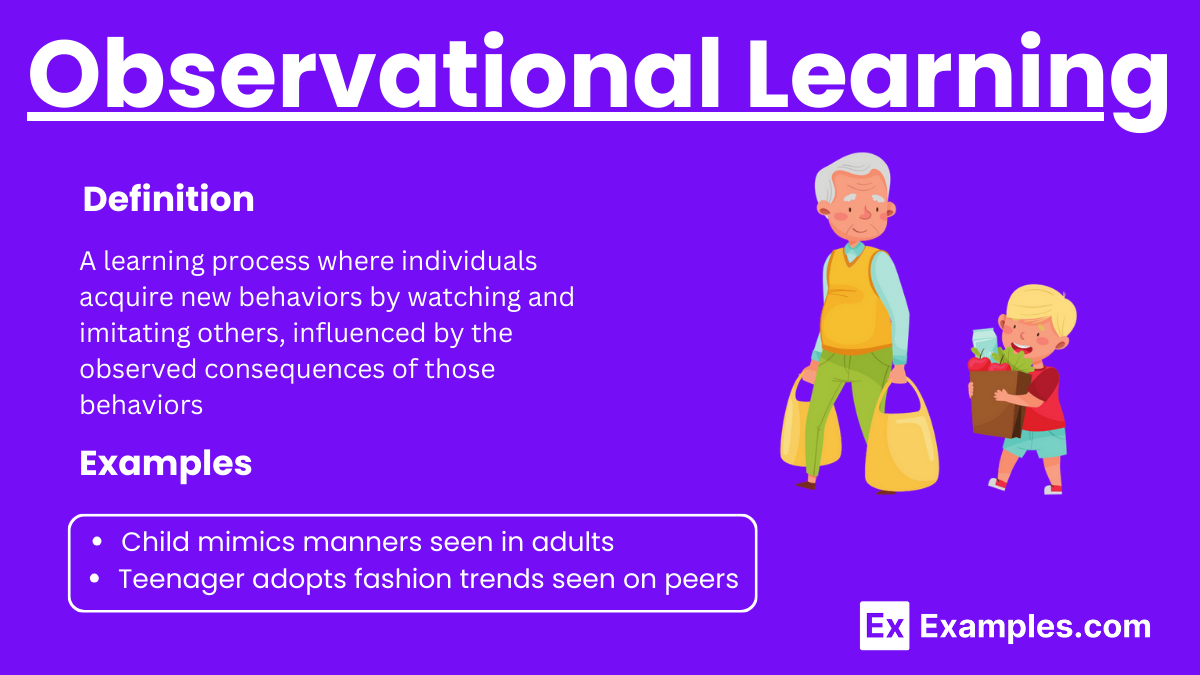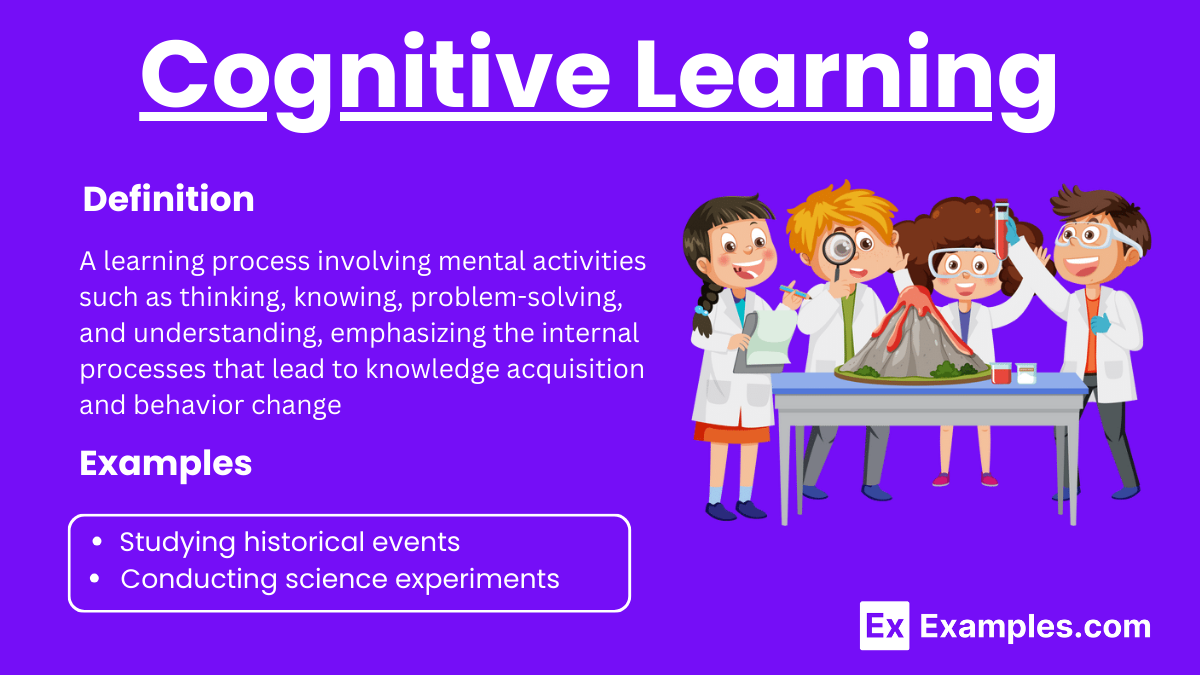Understanding the types of learning is essential in AP Psychology. This topic covers classical conditioning, where associations between stimuli are formed; operant conditioning, where behaviors are influenced by consequences; observational learning, which involves learning through watching others; and cognitive learning, emphasizing mental processes. Each type offers unique insights into how behaviors are acquired and modified, providing a comprehensive view of the mechanisms behind learning and behavior change.
Learning Objectives
Understand the key concepts and principles of classical conditioning, operant conditioning, observational learning, and cognitive learning. Recognize the components, processes, and real-world applications of each type of learning. Be able to identify examples and explain the significance of reinforcement, punishment, modeling, and cognitive processes in behavior modification. Additionally, grasp the theories and experiments associated with each learning type, such as Pavlov, Skinner, Bandura, and Tolman.
1. Classical Conditioning
Definition: Classical conditioning is a form of learning in which an organism comes to associate a previously neutral stimulus with a stimulus that naturally and automatically produces a response.
Key Components
Unconditioned Stimulus (US) : An unconditioned stimulus is something that naturally and automatically triggers a response without any prior learning. This stimulus is inherently significant to the organism and elicits an automatic reaction.
Unconditioned Response (UR) : The unconditioned response is the unlearned, naturally occurring reaction to the unconditioned stimulus. This response is automatic and does not require any previous conditioning.
Conditioned Stimulus (CS) : A conditioned stimulus is an originally neutral stimulus that, after being paired repeatedly with an unconditioned stimulus, begins to trigger a conditioned response. This stimulus becomes significant through association.
Conditioned Response (CR) : The conditioned response is the learned response to the previously neutral stimulus that has become conditioned. This response is similar to the unconditioned response but is triggered by the conditioned stimulus.
Process of Classical Conditioning
Acquisition : Acquisition is the initial stage of learning when the organism begins to associate the neutral stimulus with the unconditioned stimulus. During this phase, the neutral stimulus is presented just before the unconditioned stimulus. Over time, the neutral stimulus becomes a conditioned stimulus, eliciting the conditioned response.
Extinction : Extinction occurs when the conditioned stimulus is repeatedly presented without the unconditioned stimulus. As a result, the conditioned response gradually weakens and eventually disappears. Extinction does not mean the response is forgotten but rather suppressed.
Spontaneous Recovery : Spontaneous recovery is the reappearance of a conditioned response after a period of rest and no exposure to the conditioned stimulus. Even after extinction, the conditioned response can return if the conditioned stimulus is presented again, though typically in a weaker form.
Generalization : Generalization is the tendency for stimuli similar to the conditioned stimulus to evoke the conditioned response. This means that the organism does not only respond to the exact conditioned stimulus but also to similar stimuli.
Discrimination : Discrimination is the learned ability to distinguish between a conditioned stimulus and other irrelevant stimuli. This means the organism learns to respond only to the specific conditioned stimulus and not to similar stimuli.
Importance of Classical Conditioning
Learning Emotional Responses : Classical conditioning plays a crucial role in the development of emotional responses. It helps explain how certain stimuli can evoke emotional reactions, such as fear or pleasure, based on past experiences.
Behavioral Therapy : Understanding classical conditioning is essential for developing behavioral therapies. Techniques such as systematic desensitization rely on principles of classical conditioning to help individuals overcome phobias and anxiety disorders.
2. Operant Conditioning
Definition: Operant conditioning is a type of learning where behavior is influenced by the consequences that follow. Developed by B.F. Skinner, it involves modifying behavior through reinforcement (which increases behavior) or punishment (which decreases behavior).
Key Concepts
Reinforcement
Reinforcement is any event that strengthens or increases the frequency of a behavior. There are two main types of reinforcement:
Positive Reinforcement: Adding a desirable stimulus to increase a behavior. For example, giving a reward for good behavior.
Negative Reinforcement: Removing an aversive stimulus to increase a behavior. For example, taking away an unpleasant task when the desired behavior is performed.
Punishment
Punishment is any event that decreases the frequency of a behavior. There are two main types of punishment:
Positive Punishment: Adding an aversive stimulus to decrease a behavior. For example, scolding a child for misbehaving.
Negative Punishment: Removing a desirable stimulus to decrease a behavior. For example, taking away a toy when a child misbehaves.
Schedules of Reinforcement
The frequency and timing of reinforcement can significantly affect the strength and rate of the learned behavior. Schedules of reinforcement are divided into continuous and partial (intermittent) schedules:
Continuous Reinforcement: Providing reinforcement every time the desired behavior occurs. This schedule is effective for establishing new behaviors but can lead to rapid extinction if reinforcement stops.
Partial (Intermittent) Reinforcement: Providing reinforcement only part of the time. This schedule leads to more robust and resistant behavior. It includes:
Fixed-Ratio Schedule: Reinforcement is given after a set number of responses. For example, a reward after every five correct answers.
Variable-Ratio Schedule: Reinforcement is given after an unpredictable number of responses. This schedule leads to high and steady response rates.
Fixed-Interval Schedule: Reinforcement is given after a fixed amount of time has passed. For example, a reward for the first correct response after every minute.
Variable-Interval Schedule: Reinforcement is given after varying time intervals. This schedule produces slow but steady responses.
Shaping : Shaping involves reinforcing successive approximations of a target behavior. This technique is useful for teaching new behaviors by rewarding closer and closer approximations to the desired behavior until the exact behavior is achieved.
Extinction : Extinction occurs when a previously reinforced behavior is no longer reinforced, leading to a decrease in the frequency of that behavior. Over time, the behavior may diminish or stop altogether.
Discriminative Stimulus : A discriminative stimulus is a cue that signals the availability of reinforcement or punishment. It sets the occasion for a particular response to occur, indicating that a specific behavior will be followed by a consequence.
Importance of Operant Conditioning
Behavioral Modification : Operant conditioning principles are widely used in behavioral modification programs. Techniques such as token economies, time-outs, and contingency contracts rely on reinforcement and punishment to change behavior.
Education : In educational settings, operant conditioning is used to promote desired behaviors and discourage undesired ones. Positive reinforcement, such as praise and rewards, encourages student participation and achievement.
Workplace : Employers use operant conditioning to shape employee behavior through incentives, bonuses, and performance reviews. Positive reinforcement can enhance productivity and job satisfaction.
Therapy : Therapeutic interventions, such as applied behavior analysis (ABA), use operant conditioning principles to improve behaviors in individuals with developmental disorders, such as autism spectrum disorder.
3. Observational Learning
Definition: Observational learning, also known as social learning or modeling, is a type of learning that occurs by watching and imitating the behaviors of others. Albert Bandura, a prominent psychologist, developed the Social Learning Theory, which emphasizes the importance of observing, modeling, and imitating the behaviors, attitudes, and emotional reactions of others.
Key Components
Attention : For observational learning to occur, an individual must pay attention to the behavior being modeled. Factors that influence attention include the complexity of the behavior, the characteristics of the model, and the observer's cognitive capabilities.
Retention : The observer must be able to remember the behavior that has been observed. This involves encoding the behavior into memory for later retrieval. Retention can be influenced by the observer's ability to organize and rehearse the behavior mentally.
Reproduction : The observer must have the ability to reproduce or imitate the behavior. This involves physical and cognitive capabilities to carry out the modeled behavior. Practicing the behavior improves the observer's ability to replicate it accurately.
Motivation : The observer must have a reason to imitate the behavior. Motivation can be influenced by anticipated rewards or punishments, the perceived value of the behavior, and the observer's internal drives.
Vicarious Reinforcement/Punishment : Learning can occur through vicarious reinforcement or punishment, where the observer witnesses the model being rewarded or punished for a behavior. This influences the likelihood of the observer performing the same behavior.
Importance of Observational Learning
Socialization : Observational learning is crucial for socialization. Children learn social norms, values, and behaviors by observing parents, peers, teachers, and media. This learning process helps individuals integrate into society.
Skill Acquisition : Many skills, such as language, problem-solving, and motor skills, are learned through observation. Watching others perform tasks provides a template for individuals to follow and practice.
Behavioral Therapy : Observational learning principles are applied in therapeutic settings to teach new behaviors and coping strategies. Therapists model appropriate behaviors, which clients then imitate to improve their functioning.
Education : Teachers use modeling to demonstrate academic skills, social behaviors, and classroom routines. Students learn by observing teacher demonstrations and peer interactions, enhancing their educational experience.
4. Cognitive Learning
Definition: Cognitive learning is a type of learning that involves mental processes such as thinking, knowing, problem-solving, and understanding. It focuses on the inner activities of the mind and how these processes influence learning.
Key Concepts
Insight Learning : Insight learning occurs when a person suddenly realizes how to solve a problem without any trial-and-error behavior. This type of learning emphasizes the role of cognitive processes in understanding and applying knowledge.
Latent Learning : Latent learning is knowledge that is acquired without any obvious reinforcement and remains hidden until there is a need to use it. This type of learning demonstrates that learning can occur without immediate changes in behavior.
Cognitive Maps : Cognitive maps are mental representations of physical locations. They allow individuals to visualize and navigate environments effectively. This concept highlights the importance of internal cognitive processes in learning.
Observational Learning : Although also central to Social Learning Theory, observational learning involves understanding and imitating the behavior of others. This type of learning emphasizes the role of observation and modeling in the acquisition of new behaviors and knowledge.
Information Processing : Information processing involves the ways individuals perceive, analyze, manipulate, use, and remember information. This approach compares the human mind to a computer, focusing on how information is encoded, stored, and retrieved.
Processes of Cognitive Learning
Attention : Attention is the process of focusing cognitive resources on specific stimuli. Effective learning requires paying attention to relevant information and filtering out distractions.
Perception : Perception involves interpreting sensory input to understand the environment. This process is critical for recognizing patterns and making sense of new information.
Memory : Memory is the ability to encode, store, and retrieve information. It plays a crucial role in learning by allowing individuals to retain and recall knowledge over time.
Thinking : Thinking encompasses the mental manipulation of information to form concepts, solve problems, make decisions, and reflect critically. It involves processes such as reasoning, problem-solving, and creativity.
Metacognition : Metacognition refers to the awareness and regulation of one's own learning processes. It involves planning, monitoring, and evaluating cognitive activities to enhance learning and problem-solving.
5. Social Learning Theory
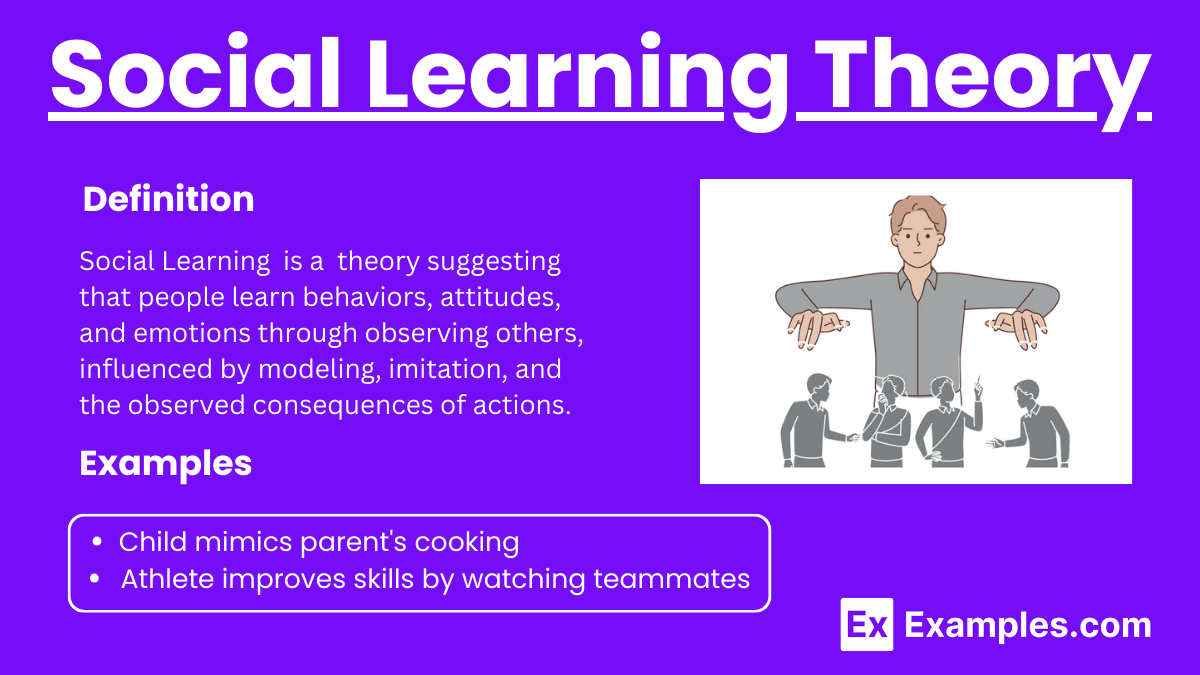
Definition: Social Learning Theory, developed by Albert Bandura, posits that people learn behaviors, attitudes, and emotional reactions through observing others. It emphasizes the importance of observing, modeling, and imitating the behaviors, attitudes, and emotional reactions of others.
Key Concepts
Observational Learning : Observational learning occurs when individuals learn by watching the actions of others and the outcomes of those actions. This process involves attention, retention, reproduction, and motivation.
Modeling : Modeling is the process of observing and imitating a specific behavior. Models can be real people (live models), characters in media (symbolic models), or even imagined figures.
Vicarious Reinforcement and Punishment : Individuals learn not only by experiencing reinforcement or punishment directly but also by observing others being rewarded or punished for their actions. This observation influences whether the observer will imitate the behavior.
Self-Efficacy : Self-efficacy refers to an individual's belief in their ability to succeed in specific situations or accomplish a task. High self-efficacy can enhance motivation and performance, while low self-efficacy can hinder them.
Reciprocal Determinism : Reciprocal determinism is the idea that behavior is influenced by and influences personal factors and the environment. This means that individual behavior, personal cognitive factors, and environmental influences all interact and affect each other.
Key Processes
Attention : To learn through observation, an individual must pay attention to the model. Factors affecting attention include the model's attractiveness, similarity to the observer, and the observer's own interest and cognitive abilities.
Retention : The observed behavior must be remembered. This involves encoding the behavior into memory and being able to retrieve it later. Techniques like mental rehearsal can improve retention.
Reproduction : The observer must have the physical and cognitive capability to reproduce the observed behavior. Practice and feedback can enhance the accuracy and effectiveness of reproducing the behavior.
Motivation : The observer must be motivated to replicate the behavior. Motivation can be influenced by anticipated rewards or punishments, the behavior's perceived value, and internal drives.

